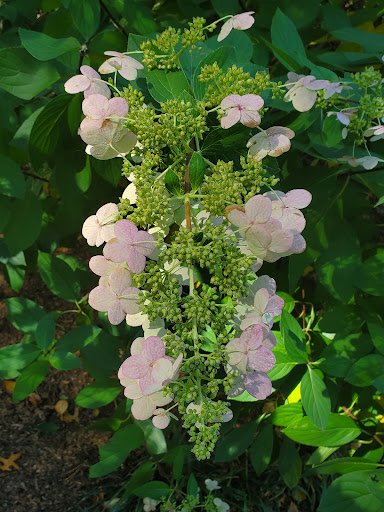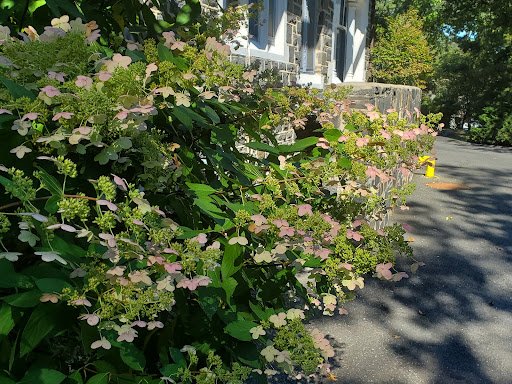On-campus flora: seven plants to keep an eye out for
Audrey Hambrick ‘25
Photo Credit: Ysabella Beatriz Chiongbian Punzalan ‘25
There’s so much beautiful flora and foliage around campus that it’s all too easy to just pass it by before giving it a closer look. Here are seven plants to keep an eye out.
Plant: Spiderwort
Plant type: Herb
Genus name: Tradescantia
One location it can be found: in “The Green” behind the Barb on the second floor
These spiderwort flowers add a nice pop of purple to “The Green” area just outside the second floor of the Barbara Walter Campus Center. The origin of the name spiderwort has two theories: some say the leaves and stems resemble spider’s legs, while others believe that spiderwort gained its name from the sap that oozes when the plant is cut, the sap resembling spiderwebs. Native Americans used every part of the flower for food or for medicinal purposes, such as using the roots to make a paste to treat wounds or roasting the seeds for eating. Studies in 1979 by Dr. Sadao Ichikawa, a geneticist at Saitama University in Japan, revealed that spiderworts can detect levels of radiation in the atmosphere, as the stamen hairs are sensitive to exposure and will transition from blue to pink.
Plant: Buckeye
Plant type: Tree, shrub
Genus: Aesculus
One location it can be found: Backyard of Andrews House
This shrub produces buckeyes, brown nuts with a tan patch, after its white flowers bloom in the summer. The small patch is reminiscent of a deer’s eye, earning the nuts the name “buckeyes.” Although the nuts may seem like chestnuts, you wouldn’t want to make the fatal mistake of eating the nuts without preparing them. The buckeyes contain toxins that cause gastrointestinal and neuromuscular problems and eating unprepared nuts can poison humans with symptoms not limited to diarrhea, vomiting, paralysis, and dilated pupils. Native Americans took advantage of these toxins, crushing the seeds and throwing them into stagnant bodies of water to stun or kill the fish in them. With that in mind, keep curious minds and mouths away from the fruit. For those who do want to try a buckeye, why not the candy modeled after their appearance? Buckeye candies, peanut butter fudge balls dipped in chocolate, are popular in the Buckeye State, Ohio, and are completely toxin-free.
Plant: Panicled hydrangea
Plant type: Shrub
Botanical name: Hydrangea paniculata
One location it can be found: around the Westlands building
These panicle hydrangea bushes resemble the drops of pinkish watercolor from a painter’s brush. Native to China and Japan, the flowers grow in a cluster, also known as a panicle. Hydrangeas hold the symbol of apology in Japan, originating from a legend. A Japanese emperor gave hydrangeas to his maiden as an apology for neglecting her while attending to business matters. Containing leaves with cyanide, this plant is a reminder to appreciate its beauty through sight and not through ingestion.
Plant name: Yew
Plant type: Shrub
Botanical name: Taxus baccata
One location it can be found: in Andrews House backyard
The bright red berries in this shrub may take a second or two to notice in this shrub. With long and thin needles this plant gives off a Christmassy vibe. Yew is native to Europe and northern Africa, Iran and southwestern Asia. Also known to grow as trees, the yew has gained the moniker of the “tree of death,” with all parts of the plant being highly toxic. Unlike other conifers such as cedars, redwoods, or pines, yew does not have its seeds in cones but in berry-like structures called arils. Its wood proved to be very valuable in the Middle Ages, used for furniture, instruments and English longbows. Despite its toxicity, yew leaves contain the substance taxol, which has been used in research in developing anti-cancer drugs
Plant: Sweet Potato
Botanical name: Ipomoea batatas
One location it can be found: in front of Westlands
Although these vines aren’t producing any sweet potatoes, the sweet potato leaves look vibrantly yellow-green underneath the sun. Sweet potatoes are a type of morning glories. Interestingly, the sweet potatoes themselves do not have a close relationship with potatoes. Ornamental vines like the ones found on campus have tubers that can be eaten, although they are considered less tasty than their counterparts that are bred for food. In addition to adding a tropical feel to a garden, cuttings of both edible and ornamental sweet potato vines will grow roots in water. This property has a helpful effect in home aquariums, as the plant helps remove ammonia and nitrates, waste products of aquatic life.The plant is native to the tropical areas of the Americas, with its exact origins being in either Central or South America.
Plant name: Busy Lizzy
Plant type: Herb
Botanical name: Impatiens walleriana
One location it can be found: in front of Westlands
Native to Eastern Africa (Tanzania and Mozambique), this flowering herb’s beauty has gained its popularity as an ornamental plant. When their seed pods are ripe, they may explode even from a single touch. This is how impatiens gains its name: from the Latin word impatiens, meaning “impatience.” Its alias is “busy Lizzie,” as it blooms continuously throughout summer to fall. In some areas of the world such as China, Brazil and Costa Rica, the plant is considered invasive, as it forms in large areas in secondary forests (forests that have regrown after human or natural disturbances), competing with the native plants already there. In ancient China, impatiens petals were combined with roses, orchids and alum to make nail polish.
Plant name: Japanese dogwood
Plant type: Tree
Botanical name: Cornus kousa
One location it can be found: outside the Alice Stone Ilchman Science Center
You may have seen the fruit of this tree, squished open on the sidewalk, oozing yellow or orange pulp. Dogwood is native to East Asia in Japan, Korea and China and is also naturalized in New York, after its introduction to the United States in the 19th century. Also known as Kousa dogwood, the tree grows edible fruits that are said to have a sweet and creamy flavor, although the outer red skin has a grainy and bitter taste. The fruit has been incorporated in numerous culinary forms, such as bread, muffins, pies, and even wine. Dogwood produces white leaves in the spring that may look like petals to the untrained eye. The leaves turn a nice red during the fall.
These seven plants are only a small sliver of Sarah Lawrence’s interesting array of greenery. Be sure to keep an eye out for other plants when you have the time!













